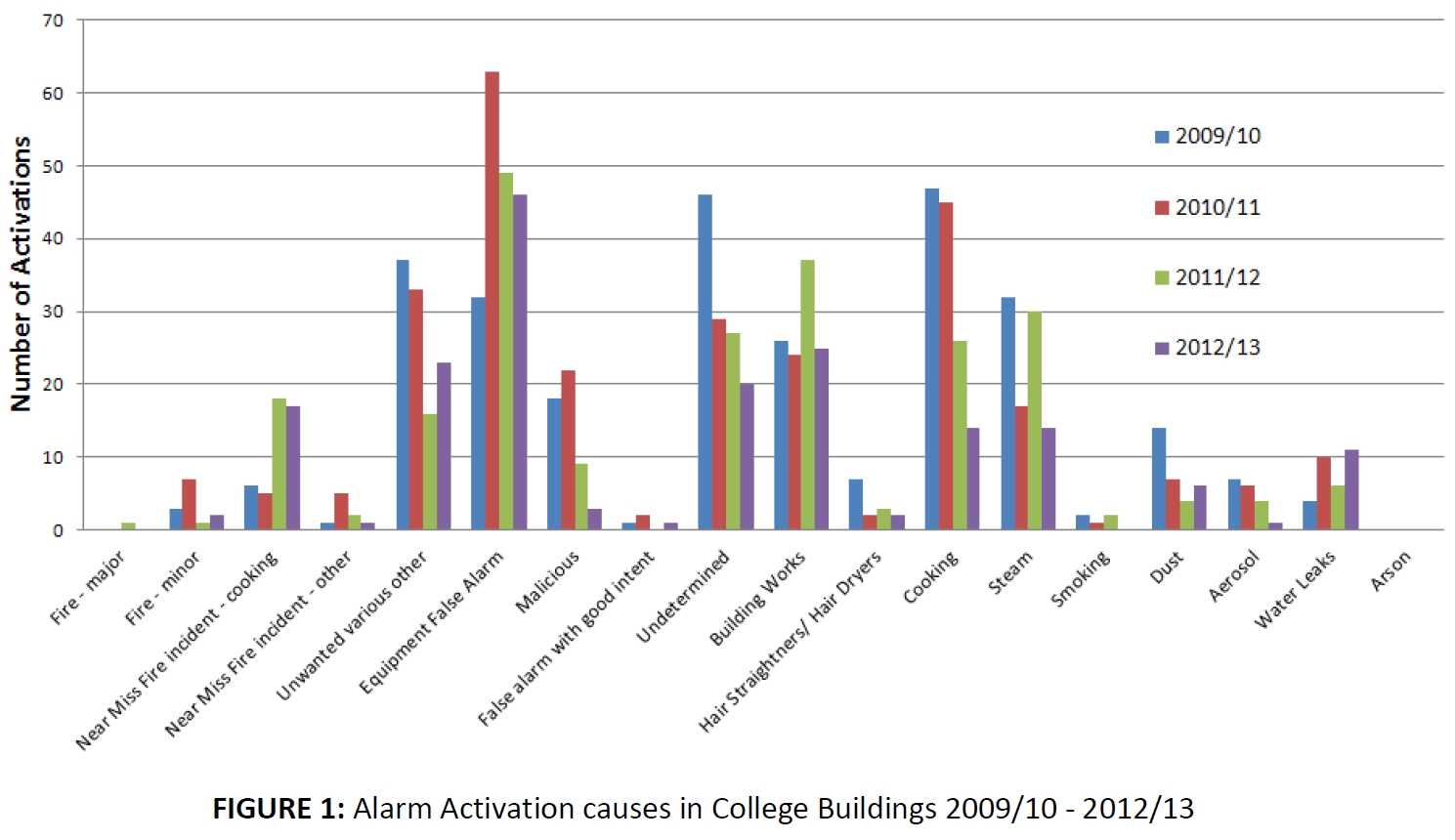The causes of false fire alarms in buildings
A false alarm is a fire alarm signal resulting from a cause, or causes, other than a fire, in which a fire detection and alarm system has responded, such as:
- A fire-like phenomenon or environmental influence (such as smoke from a nearby bonfire).
- Accidental damage.
- Inappropriate human action (such as malicious manual call point (MCP) activation).
- Equipment false alarms, resulting from a fault in the system.
A false alarm becomes an unwanted fire signal (UWFS) when the Fire and Rescue Service (FRS) is requested to attend.
In the period 2011-2012 there were 584,500 alarms reported in Britain. 53.4% of these were not fires and therefore considered “False alarms”. This is a drain on the FRS authorities and causes business disruptions leading to a loss of productivity and reducing the confidence of the general public.
False alarms generated from remotely monitored fire detection and fire alarm systems cost businesses and FRS authorities an estimated £1 billion a year in the UK. Ref London Fire Brigade 2012.
The causes of false fire alarms in buildings was written by R. Chagger, D. Smith and published by BRE Global in 2014. The briefing paper collates information about the causes of false alarms in buildings and identifies approaches to reduce their occurrence.
It was based on data from Kings College London and Buckinghamshire & Milton Keynes Fire Authority. The data supplied provides a snapshot of the types of false alarms that are observed but is not a comprehensive account of what might be the most common causes in the UK.
Kings College London provided data from 699 false alarm incidents and following a thorough review of the data, 6 physical interventions were identified that would address all of the false alarms reported. Replacement of the existing detectors with intelligent multi-sensor detectors (that detect more than one fire phenomena) was the solution that could reduce false alarms the most (by 69%).
Discussions with the Unwanted Fire Signals Officer of Buckinghamshire and Milton Keynes Fire Authority and analysis of their false alarm trends revealed that the use of a technical and experienced individual dedicated to investigating false alarms and engaging directly with regular offenders is a very effective means for FRS’s to reduce false alarms.
However, reducing the number of false alarms from domestic premises remains a challenge despite the fact that the vast majority are reportedly related to cooking incidents. Educating homeowners on effective installation and use of detectors in and around kitchens is likely to lead to the greatest reduction in false alarms from the domestic environment.
The Incident Recording System, used by Fire Officers to report on all callouts attended, lacks sufficient detail to accurately classify false alarm causes. However educating building owners, responsible persons and the general public could contribute significantly to reducing false alarms as simple measures can often cause notable reductions.
In addition, the increased use of multi-sensor detectors may avert false alarms from common causes such as cooking fumes, steam and so on.
[edit] Related articles on Designing Buildings Wiki
- BRE articles on Designing Buildings Wiki.
- Carbon monoxide detector.
- Fire.
- Fire detection and alarm system.
- Fire performance of external thermal insulation for walls of multistorey buildings, third edition (BR 135).
- Fire protection engineering.
- Heat alarm.
- Ionisation smoke alarm.
- Intruder alarm.
- Live investigations of false fire alarms.
- Multi-sensor alarm.
- New requirements for fire detection and alarm network systems IP 12 13.
- Optical smoke alarm.
- Over £1 billion lost every year due to false alarms.
- Project SHOUT.
- Smoke alarm.
- The role of codes, standards and approvals in delivering fire safety.
- Understanding the factors affecting flashover of a fire in modern buildings.
Featured articles and news
International Electrician Day, 10 June 2025
Celebrating the role of electrical engineers from André-Marie Amperè, today and for the future.
New guide for clients launched at Houses of Parliament
'There has never been a more important time for clients to step up and ...ask the right questions'
The impact of recycled slate tiles
Innovation across the decades.
EPC changes for existing buildings
Changes and their context as the new RdSAP methodology comes into use from 15 June.
Skills England publishes Sector skills needs assessments
Priority areas relating to the built environment highlighted and described in brief.
BSRIA HVAC Market Watch - May 2025 Edition
Heat Pump Market Outlook: Policy, Performance & Refrigerant Trends for 2025–2028.
Committing to EDI in construction with CIOB
Built Environment professional bodies deepen commitment to EDI with two new signatories: CIAT and CICES.
Government Grenfell progress report at a glance
Line by line recomendation overview, with links to more details.
An engaging and lively review of his professional life.
Sustainable heating for listed buildings
A problem that needs to be approached intelligently.
50th Golden anniversary ECA Edmundson apprentice award
Deadline for entries has been extended to Friday 27 June, so don't miss out!
CIAT at the London Festival of Architecture
Designing for Everyone: Breaking Barriers in Inclusive Architecture.
Mixed reactions to apprenticeship and skills reform 2025
A 'welcome shift' for some and a 'backwards step' for others.
Licensing construction in the UK
As the latest report and proposal to licence builders reaches Parliament.
Building Safety Alliance golden thread guidance
Extensive excel checklist of information with guidance document freely accessible.
Fair Payment Code and other payment initiatives
For fair and late payments, need to work together to add value.
Pre-planning delivery programmes and delay penalties
Proposed for housebuilders in government reform: Speeding Up Build Out.
High street health: converting a building for healthcare uses
The benefits of health centres acting as new anchor sites in the high street.


























